A humbucking pickup, or humbucker is a type of electric guitar pickup that uses two coils to “buck the hum” (or cancel out the interference) picked up by coil pickups.
Most pickups use magnets to produce a magnetic field around the strings, and induce an electrical current in the coils as the strings vibrate (a notable exception is the piezoelectric pickup).
Humbuckers work by pairing a coil with the north poles of its magnets oriented “up”, (toward the strings) with a coil which has the south pole of its magnets oriented up.
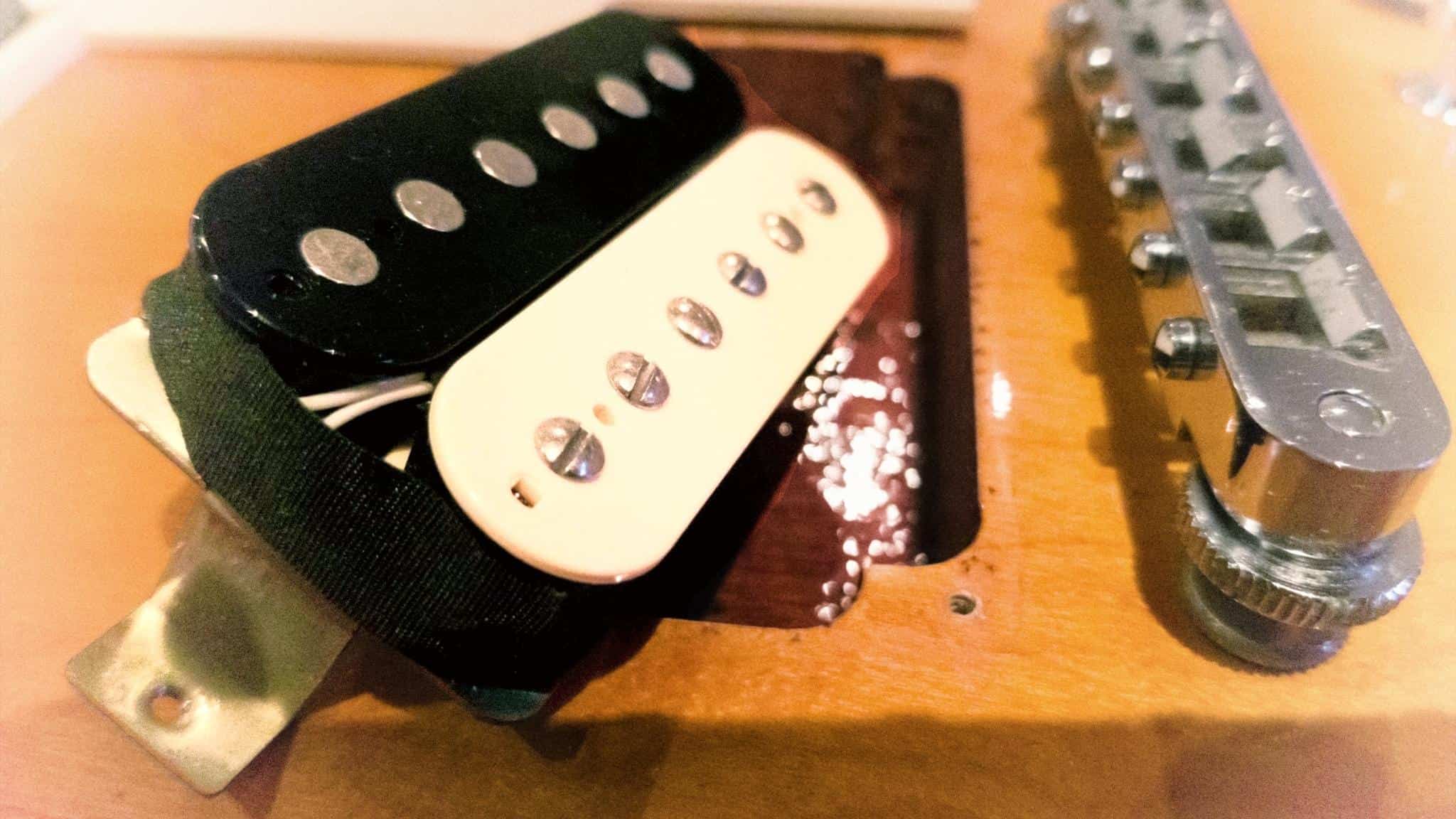
By connecting the coils together out of phase, the interference is significantly reduced via phase cancellation. The coils can be connected in series or in parallel.
In addition to electric guitar pickups, humbucking coils are sometimes used to cancel hum in dynamic microphones.
Hum is caused by the alternating magnetic fields created by transformers and power supplies inside electrical equipment using alternating current.
While playing a guitar without humbuckers, a musician would hear a hum through his pickups during quiet sections of music.
Sources of studio and stage hum include high-power amps, processors, mixers, motors, power lines, and other equipment.
Compared to unshielded single coil pickups, humbuckers dramatically reduce hum.
When were humbuckers invented?
The first humbuckers were introduced in 1934 by Electro-Voice, although these were used for various equipment, not electric guitars.
They didn’t make it inside of electric guitars until the mid-1950s when Gibson Guitar Corporation released the ES-175 model with dual-coil pickups.
Humbuckers as we know them for guitars were invented in the early 1950s by Gibson Guitar Corporation.
They were designed to cancel out the interference picked up by coil pickups, which was a common problem with electric guitars at the time.
Humbuckers are still used today in a variety of electric guitars and are one of the most popular types of pickups for heavier styles of music.
When were humbuckers popularized?
They quickly became the standard pickup for a variety of electric guitars.
They were particularly popularized in the 1960s, when rock musicians started using them to get a darker, fatter tone that was different from the brighter, thinner sound of single coil pickups.
The popularity of humbuckers continued to grow throughout the following decades, as they became a popular choice for many different styles of music.
Today, humbuckers are still one of the most widely used types of pickups, and they continue to be a favorite choice for many guitarists.
Whether you play heavy metal or jazz, there’s a good chance that at least some of your favorite artists use this type of pickup.
Guitarists that use humbuckers
Popular guitarists that use humbuckers today include Joe Satriani, Slash, Eddie Van Halen, and Kirk Hammett. You can see there are a lot of heavy rock and metal players on this list and that is for good reason.
Let’s dive into the benefits of using humbuckers.
The benefits of using humbuckers in your guitar
There are a few benefits that come along with using humbuckers in your guitar. One of the most popular benefits is that they offer a thicker, fuller sound than single coil pickups.
They also tend to be less noisy, which can be a big plus if you play in a band with a lot of onstage movement.
Humbuckers also offer a different tone than single coil pickups, which can be beneficial if you’re looking to add some variety to your sound.
They tend to have less highs and more lows, giving them a “fuller” sound.
Humbuckers are also less susceptible to interference than single coil pickups, which is why they’re a popular choice for players who do a lot of onstage movement and especially for those who use a lot of distortion (like heavy rock and metal players).
What’s the difference between humbuckers and single-coil pickups?
The biggest difference between humbuckers and single coil pickups is the sound they produce.
Humbuckers tend to have a thicker, fuller sound, while single coils tend to be brighter and thinner. Humbuckers are also less susceptible to interference.
Why are humbuckers better?
Humbuckers offer a thicker, fuller sound that many guitarists prefer. They’re also less susceptible to interference, which can be a big plus if you play in a band with a lot of onstage movement.
Do all humbuckers sound the same?
No, all humbuckers do not sound the same. The sound of a humbucker can vary depending on the type of metal used in the construction, the number of coils, and the size of the magnets.
Are humbuckers louder?
Humbuckers are not necessarily louder than single coil pickups, but they do tend to have a fuller sound. This can make them seem louder than single coils, even though they might not actually be producing more volume.
They can be used at higher volumes or with more distortion because of their ability to pick up less background noise.
When turning up the gain, background noise gets amplified as well so the more gain or distortion you use, the more it matters to cancel out as much background noise as you can.
Otherwise, you get this annoying hum in your sound.
Humbuckers also get rid of unwanted feedback you can get when playing with high gain.
Are humbuckers high output?
High output pickups are designed to produce a higher volume of sound. Humbuckers can be high output pickups, but not all of them are. It depends on the construction and materials used.
Some humbuckers are designed for a more vintage sound while others are made for a heavier, modern sound.
How do I know if a guitar has humbuckers?
The easiest way to tell if a guitar has humbuckers is to look at the pickups themselves. Humbuckers are typically twice as wide as single coil pickups.
You can also usually find the word “humbucker” printed on the pickup itself or on the baseplate if it’s mounted on one.
Are there different types of humbuckers?
Yes, there are a few different types of humbuckers. The most common type is the full-size humbucker, which is typically used in heavier styles of music.
There are also mini and single coil humbuckers, which offer a different sound and can be used for genres like jazz or blues.
There are also passive as well as active humbucker pickups.
Humbucker magnet type
One of the things that can affect the sound of a humbucker is the type of magnet used. The most common type of magnet is the Alnico magnet, which is made from aluminum, nickel, and cobalt.
These magnets are known for their rich, warm tones.
Ceramic magnets are also sometimes used in humbuckers, though they are less common. These magnets tend to have a sharper and more aggressive tone. Some players prefer this type of sound for metal or hard rock music.
Ultimately, the choice between different magnet types will depend on your personal preferences and the style of music you play. But knowing about the different options can help you make an informed decision.
Which brands make the best humbuckers?
There are a few different brands that make good humbuckers. Some of the most popular brands include Seymour Duncan, EMG, and DiMarzio.
What are the best humbucker pickups?
The best humbucker pickups will depend on the type of sound you’re going for. If you want a vintage sound, you might want to try something like the Seymour Duncan Antiquity.
If you’re looking for a heavier, modern sound, the EMG 81-X or the EMG 85-X might be a better fit.
Ultimately, the best way to choose humbucker pickups is to try out a few different options and see what works best for your style of music.
Best overall humbuckers: DiMarzio DP100 Super Distortion
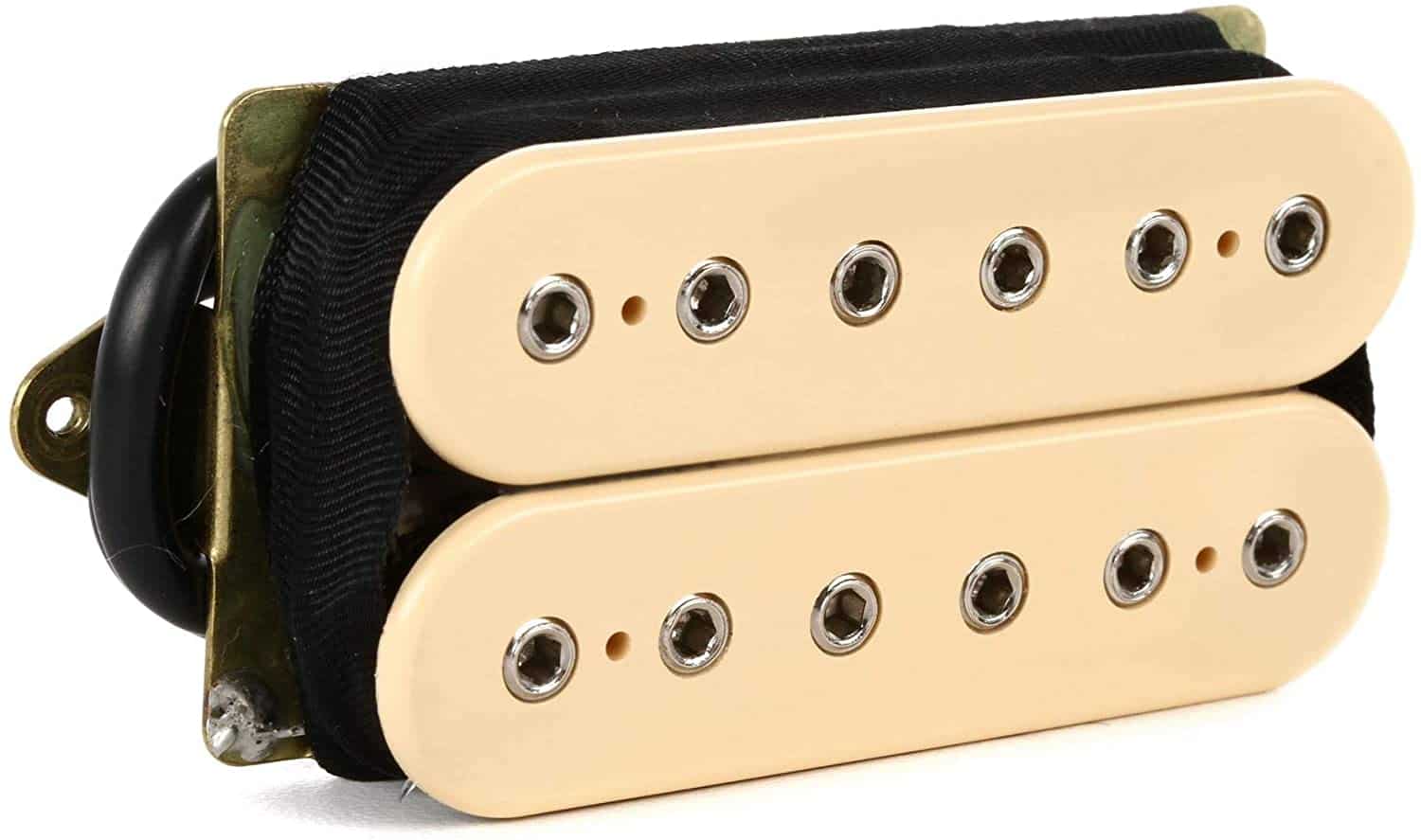
I love DiMarzio as a brand and have owned a lot of guitars with them pre-installed. It’s one of the best-known brands that offer affordable prices on their ranges.
When you get to choose what to put into your guitar, I’d advise on the DP100’s for that nice rocky grunge.
They’ve got a lot of output without being too overbearing, perfect for those high-gain amps.
What’s also great is that they can do well in other genres. I’ve had them in a few different guitars and they’ve sounded great no matter what tone I was going for.
Whether you’re looking for a darker tone or something with more bite, these humbuckers are sure to deliver. They can also be coil-split, giving you even more versatility in your sound.
Best budget humbuckers: Wilkinson Classic Tone
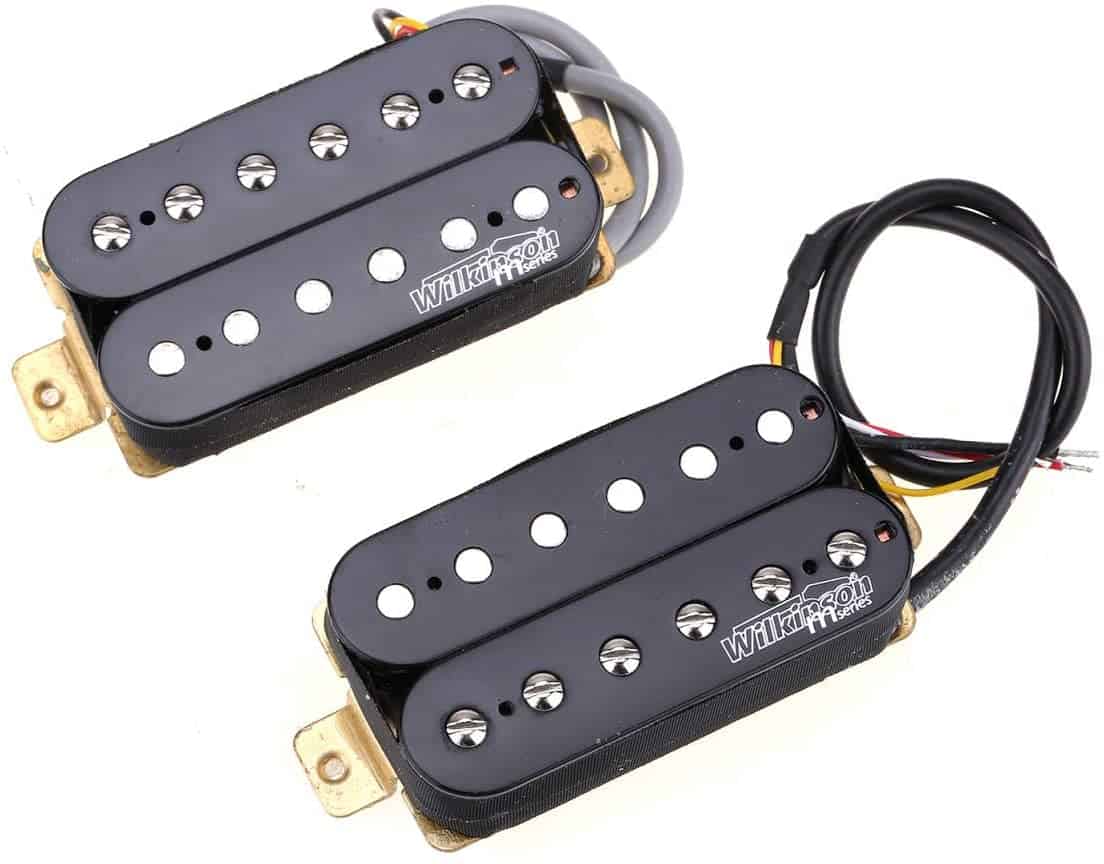
If you’re looking for affordable humbuckers that still pack a punch, the Wilkinson classic tone pickups are an excellent choice.
These humbuckers are known for their big, fat sound with tons of harmonics and character. The ceramic magnets give them plenty of output and make them perfect for heavier styles of music.
Whether you’re looking for a vintage sound or something with more modern bite, these pickups are sure to deliver. And at such a low price, they’re a great choice for budget-minded guitarists.
Best vintage-sounding humbuckers: Seymour Duncan Antiquity
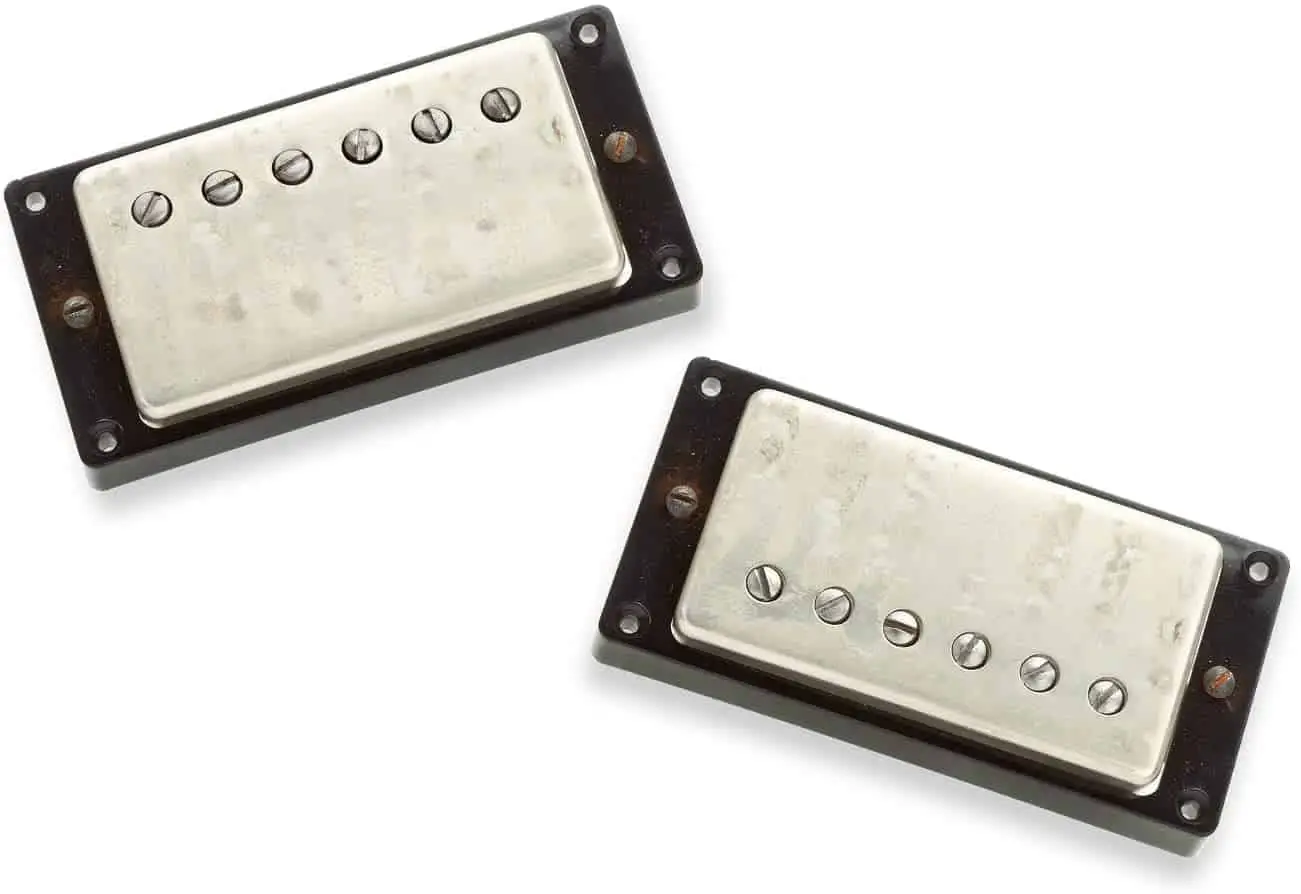
If you’re looking for vintage humbuckers with a smooth, airy tone and just enough hair, the Seymour Duncan Antiquity pickups are an excellent choice.
These pickups are custom aged to give them a true vintage look and sound, while still delivering that classic blues and rock tone we all know and love.
Whether you’re playing raw country or classic rock, these pickups make it easy to get those vintage tones without any hassle. If you’re looking for the best of both worlds, these are the pickups for you.
Best active humbuckers: EMG 81-x
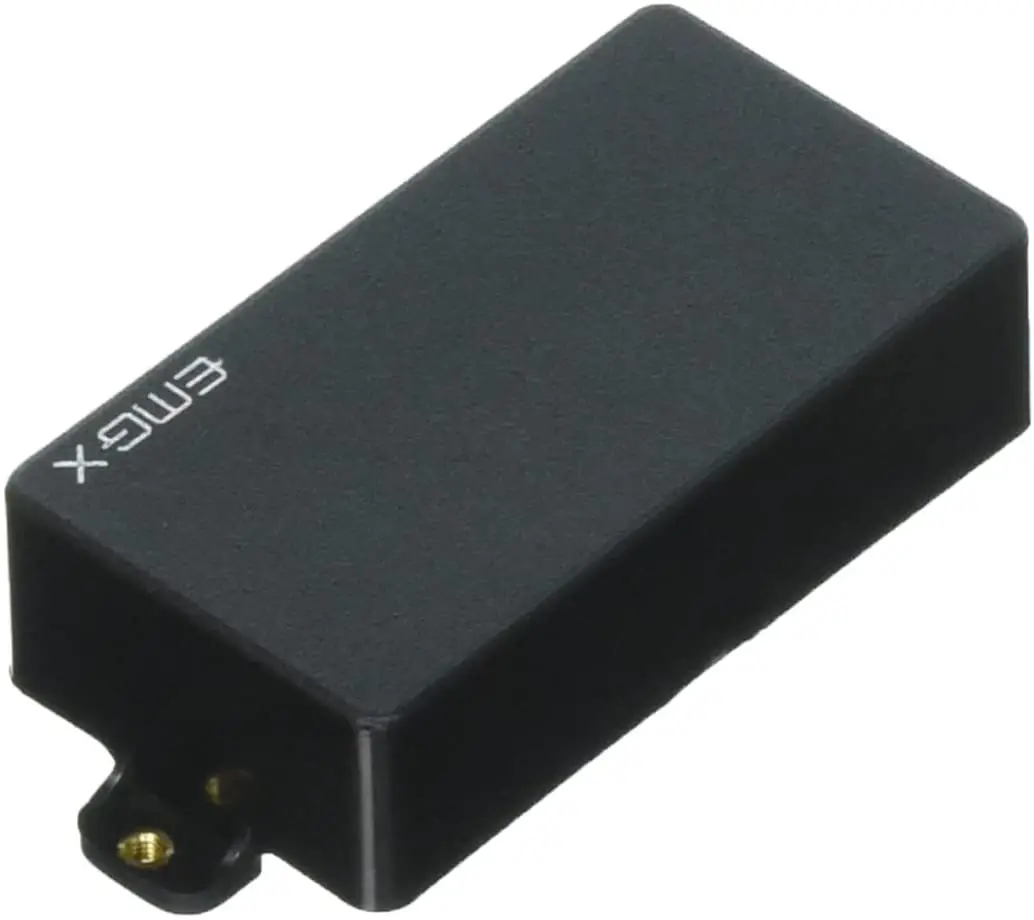
If you’re looking for the ultimate in high-gain, modern tone and output, EMG 81-x humbuckers are an excellent choice.
These pickups feature powerful ceramic magnets and close aperture coils to give them plenty of output and intensity. They also have a distinctive fluid sustain that’s perfect for lead playing.
Whether you’re looking to shred like a maniac or just want to make your solos cut through the mix, EMG 81-x humbuckers are a great choice.
If you’re looking for active pickups that can do it all, these are the ones for you.
Fishman Fluence vs EMG active pickups
Other great active pickups are the Fishman Fluence models, they are a lot more traditional sounding but are really great at cutting through the mix, even on loud stages.
Best stacked humbuckers: Seymour Duncan SHR-1 Hot Rails
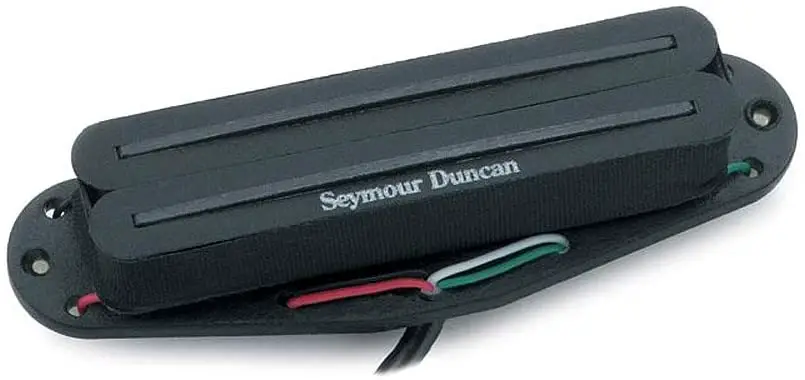
If you’re looking for high output and incredible sustain, Seymour Duncan SHR-1 Hot Rails pickups are a great choice.
These pickups feature two thin blades with powerful coil windings that give you the fat, full sound you need for playing heavier music.
They also respond to the subtlest finger movements, making them perfect for expressive lead playing.
Whether you’re a rock guitarist looking for a versatile humbucker that can handle anything, or just an experienced player in search of the perfect pickup, Seymour Duncan SHR-1 Hot Rails are tough to beat.
With their powerful tone and dynamic responsiveness, they are truly one of the best stacked humbuckers on the market today.
I put these in my Young Chan Fenix Strat (the master guitar builder at Fender) and I was immediately impressed by their responsiveness and growl, without losing too much of the twang I had with the single-coils.
What are the disadvantages of using humbuckers?
The main disadvantage of using humbuckers is that they can be more difficult to work with when trying to get a clean, bright tone.
This can make them less ideal for certain styles of music that require a lot of clean or “crisp” sounds. Some guitarists also prefer the sound of single coil pickups, which can be thinner and brighter than humbuckers.
Overall, the more “twang” you want from your guitar, the less suitable humbuckers become.
How do humbuckers cancel hum?
Humbuckers cancel hum by using two coils that are out of phase with each other. This causes the sound waves to cancel each other out, which eliminates the humming noise.
The different types of guitar that are best suited for using humbuckers
The best guitars to use humbuckers with are typically heavy-sounding guitars like metal and hard rock guitars. Humbuckers can also be used in jazz and blues guitars, but they tend to be less common in those genres.
What are some of the best humbucker-equipped guitars?
Some of the best humbucker-equipped guitars include the Gibson Les Paul, Epiphone Casino, and Ibanez RG series of guitars.
How to install humbuckers in your guitar
If you want to install humbuckers in your guitar, there are a few different steps you need to take. First, you will need to remove your existing pickups and replace them with the new humbucker pickups.
This typically involves removing some or all of the pickguard on your guitar, depending on how your existing pickups are wired up.
Usually, the pickguard that’s on the guitar will have holes big enough for single-coil pickups to be fitted, so when changing the pickups to humbuckers, you’ll need to buy a new pickguard with holes for humbuckers.
Most pickguard for single coil pickups will have three holes for three pickups, and most for humbuckers will have two holes for two humbuckers, but some will have three for two humbuckers in the bridge and neck positions and a single coil in the middle.
Since your guitar already has wiring for three pickups, the three hole pickguard will be a lot easier to use so you don’t have to mess with the wiring too much.
String spacing
String spacing is also important when installing humbuckers, as you want to make sure that the width between the strings is wide enough for your new humbuckers.
Most guitars should be able to use regular spaced magnetic pole pieces.
Replace single-coil pickups with stacked humbuckers
The easiest method to replace your single coil pickups with humbuckers is to use stacked humbuckers.
Those have the same shape as single-coil pickups so they’ll fit into your existing pickguard or guitar body and you won’t have to do any additional customization.
A single-coil sized humbucker!
Tips for maintaining and caring for your humbuckers over time
To maintain and care for your humbuckers over time, it’s important to make sure they are properly installed in your guitar.
This means ensuring that the wiring is correctly connected and that all of your pickups are aligned correctly with each other.
Other tips for maintaining and caring for your humbuckers include regularly cleaning them with a soft cloth or brush, making sure to keep them away from extreme heat or cold, and avoiding exposing them to moisture or humidity that could cause rusting or other damage.
You should also keep your strings clean and well-maintained, as dirty or worn strings can have a negative impact on your humbuckers and the overall sound of your guitar but can also cause rust more quickly.
Conclusion
There you have it! Everything you wanted to know about humbuckers, how they were popularized, and their uses in your own guitars!
Thanks for reading and keep rocking!
I'm Joost Nusselder, the founder of Neaera and a content marketer, dad, and love trying out new equipment with guitar at the heart of my passion, and together with my team, I've been creating in-depth blog articles since 2020 to help loyal readers with recording and guitar tips.

